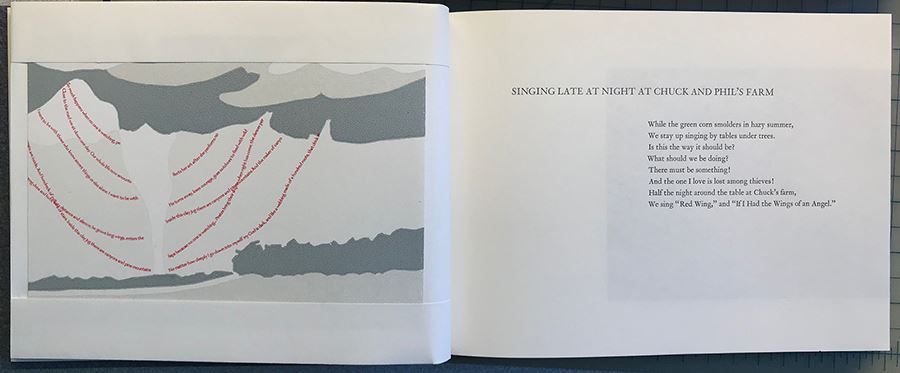Words that form tornados and wings, this is what I have been drawn to and have discovered in my looking and reading. During these last months of sheltering in place, I am recalling a prior time. [Are we sheltering from a tornado? Once here is south central Pennsylvania, my neighbor and her then young daughter came over from their mobile home to shelter in my old farmhouse basement. Over thirty years, we have had warnings and watches, but never actually seen or experienced one. This is the experience of many of us now. We have been sheltering in place, but have not seen or experienced the COVID-19, except through the media.] As a woman who came of age in the 1970s in rural Colorado, this sheltering in place has put me back in touch with a simpler, more focused time, where the days are yours for—being and thinking.
In working on a new book series and thinking about structure, I pulled out from my collection Saturday Nights in Marietta, published by Minnesota Center for Book Arts in 1999. The collection of fifteen poems by Robert Bly provides the conceptual basis for the collaborative visual interpretation by fifteen book artists and printmakers. What caught my eye and my imagination is the red tornado of words, like a red tumbleweed from the desert southwest, created by Steve Miller. His artist statement says, “The first time I read Bly’s poem, Singing Late at Night at Chuck and Phil’s Farm, I saw a thunderous tornado sweeping across the fields, and poem lines swirling from it. No matter how hard I tried to rid myself of the image, it stayed. And so I made the reduction linocut with words swirled in photopolymer types around it. The words all come from several of Bly’s poems in his book Iron John, and one of his translations of Kabir [and of Rilke] in the same book. What I saw in Singing Late at Night… unleashed a riff of Bly words for me.”

Steve Miller, reduction linocut with photopolymer type for Robert Bly’s, “Singing Late at Night at Chuck and Phil’s Farm.”
The tornado formed with type recall the English pattern poet and Anglican priest, George Herbert’s shaped poem, “Easter Wings.” Interestingly, the shape of Miller's words also evokes wings to me. Herbert was influenced by the Renaissance revival of pattern poems, dating back to the Hellenistic era of the 3rd and 2nd BCE preserved in Greek Anthology texts. The content expressed by shape in “The Axe” and “The Wings” by the Greek poet Simias of Rhodes deeply informed Herbert’s work.
.jpg)
George Herbert, “Easter Wings,” published in The Temple, 1633.
In Herbert’s set of “Easter Wings,” the lines mimic each other in meaning across the pair of wings. The visual shape recalls angels. The text reveals fallen man who then rises, like Christ on Easter. Herbert exclaims, “O let me rise, As larks, harmoniously, And sing ….” The shape mimics the poem’s sense, and though self-contained opens inner possibilities. Likewise, the allusive Greek poem “The Wings,” describes the winged god of love’s coming to be, by “gentle-persuasion,” “a judge among gods” of “Earth, deep Sea, and brazen Heaven” (translation by J.M. Edmonds, Greek Pattern Poems). Whether the resulting visual poem is termed pattern, material, or concrete poetry—the desire to expand meaning is both old and new, and yet, culturally and aesthetically specific to its many situations.

Simias of Rhodes, “The Axe” and “The Wing,” about 300 BCE. (In “The Axe,” the lines are read alternating from the top to the bottom, working to the middle, following the numbered lines.)
In “Singing Late at Night,” Steve Miller creates a tornado in red words, with the line: “No matter how deeply I go down into myself my God is dark, and like a webbing made of a hundred roots, that drink in….” The tornado of words rises like wings—creating a place of emptiness where lament and hope meet. Fittingly, Robert Bly’s poem ends with, “We sing ‘Red Wing’ and ‘If I Had the Wings of an Angel.’” Nowhere does the poem mention a tornado. Maybe it is the green corn smoldering in the hazy summer heat. Maybe it is the irrepressible singing late into the night with friends gathered under dark skies.
Robert Bly’s poem “Singing Late at Night at Chuck and Phil’s Farm”:
“While the green corn smolders in hazy summer,
We stay up singing by tables under trees.
Is this the way it should be?
What should we be doing?
There must be something!
And the one I love is lost among thieves!
Half the night around the table at Chuck’s farm,
We sing “Red Wing” and “If I Had the Wings of an Angel.”
.jpg)
Detail, Steve Miller, for Robert Bly’s, “Singing Late at Night.”
I was struck by Robert Bly’s questions: “Is this the way it should be? What should we be doing? There must be something!” These seem like apt questions for us now.
The discussion of shaped text continues in the next post: Shapes of Words/Eggshells in Fields of Type.
KT Hettinga is an award-winning artist in design, artist’s books, digital images/prints, and photography. Twice awarded the Distinguished Professor of Art, she designs for non-profits. Her books are in collections from NMWA to UCLA. Residencies include: Yale Research Fellow, Luce Center for Arts and Religion, Pyramid Atlantic, WSW and VSW.

